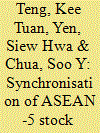| Srl | Item |
| 1 |
ID:
136557


|
|
|
|
|
| Summary/Abstract |
The aim of this article is to examine the income and employment multiplier effects of the higher education sector in Malaysia based on conventional input–output methodology. We examined simple, total, Type I and Type II income and employment multiplier effects of private and public higher education institutions (HEIs) in Malaysia. We found that private HEIs have larger direct and indirect income impacts than public HEIs. With the presence of household spending, both public and private HEIs have greater induced income impacts than direct and indirect income generation effects. We also found that Type I multipliers for private and public HEIs lead to additional income of 1.34 and 1.32 for every initial Ringgit of labour income, respectively, while Type II income multipliers for private and public HEIs account for additional income of 3.09 and 3.05, respectively. Higher education creates 1.21 workers per RM 10,000 INVESTMENT. The overall results show that private higher education has a relatively greater income effect on the economy.compared to public higher education. The higher education sector is also found to be ineffective in creating new employment in the economy.
|
|
|
|
|
|
|
|
|
|
|
|
|
|
|
|
| 2 |
ID:
117676


|
|
|
|
|
| Publication |
2013.
|
| Summary/Abstract |
This study explores the changing direction and degree of financial integration of the emerging economies, People's Republic of China (PRC) and India, with ASEAN-5 and compares it to the developed economies, the US and Japan, in a time-varying framework. The concordance and rolling concordance indices are used to study the cyclical behaviour in the ASEAN-5 stock markets with the economic activity of the emerging and developed economies. This study covers the period between January 1991 and June 2010. One of the more significant findings from this study is that ASEAN-5 stock markets do not react as a whole to external shock from these four trading partners. Each stock market in ASEAN-5 responded differently in terms of direction and degree towards the influences of the economic condition in these emerging and developed economies. The ASEAN-5 stock markets were less correlated with economic activities in emerging economies but were more aligned with economic activities in developed economies. In summary, ASEAN-5 stock market cycles were still more dependent on the developed economies' growth rate cycles.
|
|
|
|
|
|
|
|
|
|
|
|
|
|
|
|